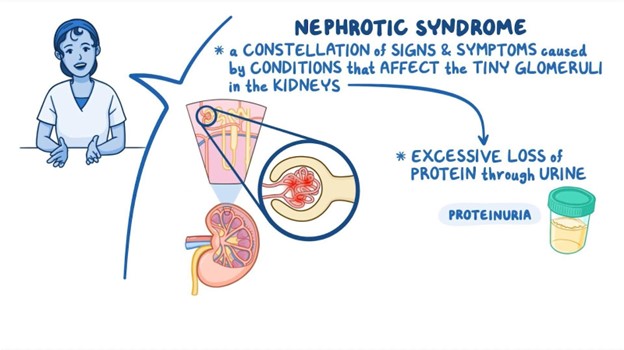A 4-year-old with nephrotic syndrome is experiencing severe periorbital edema. The best measure the nurse could institute to help reduce the periorbital edema is:
apply cool sterile soaks to the child's head
apply warm compresses
encourages the child to eat low protein foods
elevate the head of the bed
The Correct Answer is B
A. Apply cool sterile soaks to the child's head.
Explanation: Applying cool sterile soaks to the child's head would not directly address periorbital edema. Nephrotic syndrome is a kidney disorder that results in proteinuria (loss of protein in urine), leading to fluid accumulation and edema. Cooling the head would not have a significant impact on reducing periorbital edema caused by nephrotic syndrome.
B. Apply warm compresses.
Explanation: Correct Choice. Applying warm compresses can help increase blood circulation and promote the reabsorption of excess fluid causing periorbital edema. Warmth can dilate blood vessels and improve the movement of fluids, potentially alleviating the edema.
C. Encourage the child to eat low protein foods.
Explanation: While dietary modifications might be part of managing nephrotic syndrome, specifically encouraging low protein foods may not directly address periorbital edema. The primary treatment for nephrotic syndrome involves medications to control proteinuria and manage fluid balance.
D. Elevate the head of the bed.
Explanation: Elevating the head of the bed is more commonly used to manage conditions like heart failure or obstructive sleep apnea. It might have some impact on overall fluid distribution, but it's not the most effective measure for reducing periorbital edema caused by nephrotic syndrome.

Nursing Test Bank
Naxlex Comprehensive Predictor Exams
Related Questions
Correct Answer is D
Explanation
A) Kidneys are very small and irregular.
Explanation: This statement is not the primary reason for instructing caregivers about preventing kidney injury in babies or children under 2 years old. While it is true that infant and toddler kidneys are relatively smaller and have a slightly different shape compared to adult kidneys, the main concern for kidney injury prevention in this age group is related to other factors.
B) The occurrence of Hirsutism.
Explanation: Hirsutism refers to excessive hair growth, typically in a male pattern, in women and children. It is not directly related to kidney injury prevention in babies or children under 2 years old. Hirsutism is usually caused by hormonal imbalances and is not a primary consideration when instructing caregivers about preventing kidney injury.
C) Diaper rashes.
Explanation: Diaper rashes are skin irritations that occur in the diaper area of infants and young children. While diaper rashes can be uncomfortable and require proper care, they are not a major concern when instructing caregivers about preventing kidney injury. Diaper rashes are typically a result of prolonged exposure to moisture and can be managed with good hygiene practices and appropriate diaper-changing routines.
D) Children under two years old are more vulnerable to kidney trauma from compression force to abdomen.
Explanation: This statement is true and is the main reason for instructing caregivers about preventing kidney injury in babies or children under 2 years old. Children in this age group have relatively larger abdomens and less developed abdominal muscles, which makes their kidneys more susceptible to injury from compression forces to the abdomen. This is why caregivers are advised to handle young children carefully, avoid rough play, and ensure that they are securely fastened in car seats and other safety devices to prevent potential kidney trauma.
Correct Answer is A
Explanation
A. "My son might complain of feeling shaky when he has a low blood glucose level."
Explanation: Correct Choice. Shaking or feeling shaky is a common symptom of low blood glucose levels, also known as hypoglycemia. When blood sugar drops too low, the body releases adrenaline, causing shaking or trembling. This response is indicative of an understanding of hypoglycemia symptoms.
B. "My son might have nausea and vomiting with hypoglycemia."
Explanation: Nausea and vomiting are not typical symptoms of hypoglycemia (low blood sugar). They are more commonly associated with hyperglycemia (high blood sugar) or other conditions. This statement is not accurate in the context of hypoglycemia.
C. "Sweating can occur with hyperglycemia."
Explanation: Sweating is more commonly associated with hypoglycemia (low blood sugar) rather than hyperglycemia (high blood sugar). When blood sugar levels drop too low, the body can respond with sweating as part of the adrenaline release. Sweating is not a typical symptom of hyperglycemia.
D. "The onset of low blood glucose usually occurs slowly."
Explanation: The onset of low blood glucose (hypoglycemia) can vary. It can occur suddenly, especially if the individual takes too much insulin or diabetes medication, leading to a rapid drop in blood sugar. The correct understanding is that the onset of low blood glucose can be rapid and not always slow.
Whether you are a student looking to ace your exams or a practicing nurse seeking to enhance your expertise , our nursing education contents will empower you with the confidence and competence to make a difference in the lives of patients and become a respected leader in the healthcare field.
Visit Naxlex, invest in your future and unlock endless possibilities with our unparalleled nursing education contents today
Report Wrong Answer on the Current Question
Do you disagree with the answer? If yes, what is your expected answer? Explain.
Kindly be descriptive with the issue you are facing.
